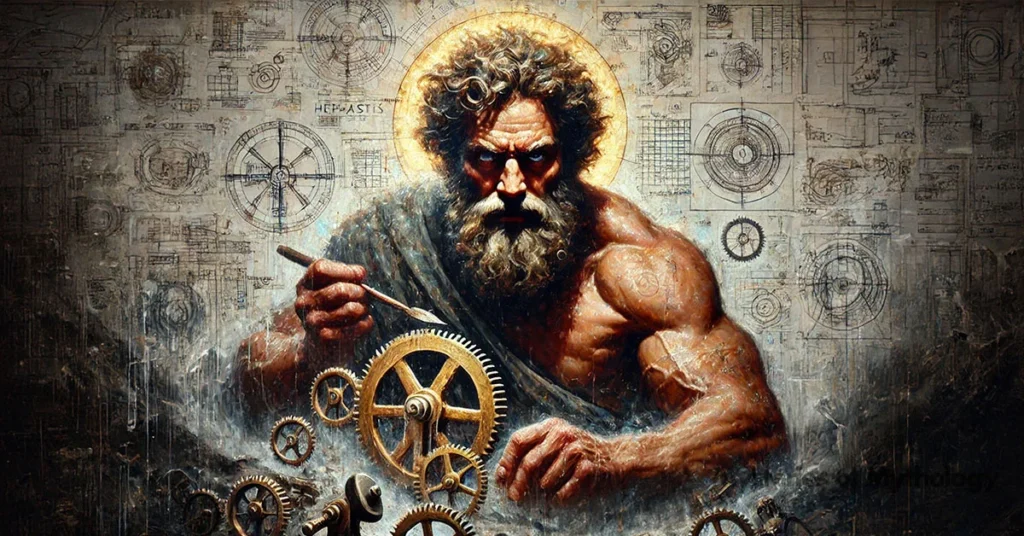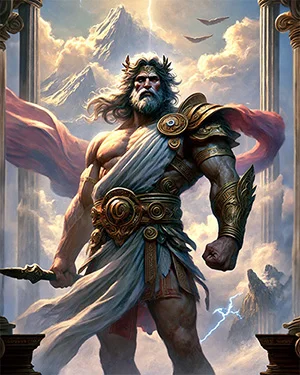Overview
Hephaestus was one of the Twelve Olympian gods and the god of blacksmiths, craftsmen, and fire. Despite being born with a limp and thrown out of Mount Olympus by his mother, Hera (and, in some versions, his father, Zeus), he became a master craftsman.
Hephaestus created amazing weapons, armour, and tools for the gods and heroes, including the shield of Achilles, the armour of Heracles, and the palaces of Olympus. One of his most famous creations was Pandora, the first woman, who was made as a punishment for humanity.
Hephaestus often worked in workshops beneath volcanoes on the islands of Lemnos and Sicily, where he used the fire to forge his creations. He was assisted by the Cyclopes, giant one-eyed beings who helped him forge powerful artefacts that enhanced the strength and powers of the other gods. Hephaestus also made the golden throne that trapped his mother, Hera, as a form of revenge for throwing him out of Olympus.
Hephaestus was married to Aphrodite, the goddess of love, although their marriage had many problems because she had many lovers, including Ares, the god of war. Despite being treated as an outsider because of his limp, Hephaestus earned respect for his incredible skills and contributions. His story shows that talent and hard work can help overcome physical challenges and earn admiration.
Hephaestus is probably the least spoken of god in Greek mythology, but he has a fascinating story. And in my opinion… I think he’s the best Greek god.
Want to know more? Read on…
Watch the related video
Etymology
The roots of the name “Hephaestus” are not entirely clear, much like many names of ancient Greek gods. The oldest known reference comes from an inscription found at the palace of Knossos on Crete, dating back to 1600-1100 BCE. This inscription, written in the Linear B script used in the Bronze Age by Mycenaean Greeks, spells the name “a-pa-i-ti-jo.” Scholars believe this may not be the exact name of the god but rather a theophoric name, meaning a name that includes a deity’s name, similar to how names like “Christopher” include “Christ” today.
The Greek name “Hephaistos” likely predates the Greek language, indicating a pre-Greek origin. Some researchers suggest it may be linked to the Greek word for volcano, “ηφαίστειον” (haphaistion), highlighting Hephaestus’s association with fire and volcanic activity. Despite these insights, the exact origins and meaning of the name remain a subject of speculation among scholars.
Pronunciation
ENGLISH
Hephaestus
Greek
Ἥφαιστος
PHONETIC
[hi-FES-tuhs]
IPA
/hɪˈfɛs təs/
Alternative names
Hephaestus, the Greek god of blacksmiths and fire, had several names and titles. In Roman mythology, he was called Vulcan. Hephaestus was often referred to as “Khalkeús” (Χαλκεύς), which means “the smith,” because he was the god of blacksmiths and metalworkers. Another title was “Polytechnes” (Πολύτεχνης), meaning “of many crafts,” highlighting his skill in various types of craftsmanship. He was also known as “Klutos tektōn” (Κλυτὸς τέκτων), which translates to “famous craftsman,” emphasizing his reputation for making incredible things. These names show Hephaestus’s importance as a creator and inventor in Greek and Roman mythology.
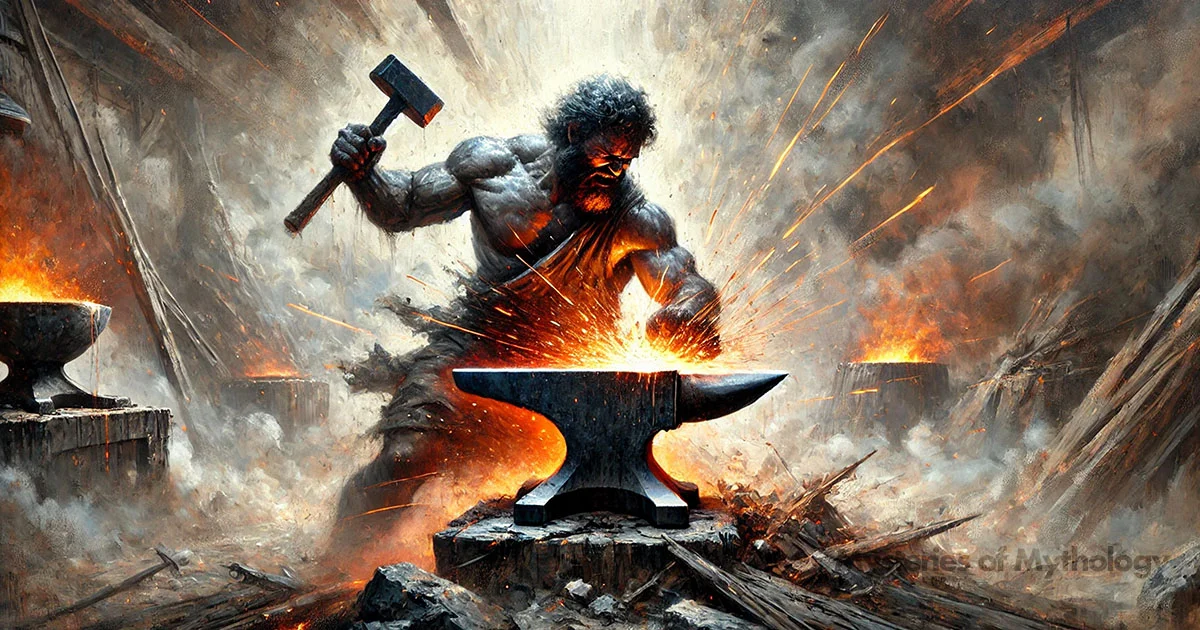
Epithets
Many of Hephaestus’s epithets referred to his physical appearance or his lameness. For example, “amphigyeis” (Ἀμφιγυήεις) means “the lame one,” and “kyllopodiōn” (Κυλλοποδίων) means “foot-dragging.” Other epithets were more positive and highlighted his amazing skills as a craftsman and smith. These included “klytotechnēs” (Κλυτοτέχνης), which means “famous artificer,” “polymētis” (Πολύμητις), meaning “shrewd,” and “chalkeus” (Χαλκεύς), which means “bronze-working.” These names show both his physical challenges and his incredible talents
Attributes
Hephaestus was typically depicted as a strong, bearded man, often wielding a hammer, anvil, and tongs, symbolising his role as the god of blacksmiths and metalworking. Unlike the other Olympian gods, he was portrayed as physically imperfect, with most of his artistic depictions focusing on his crippled leg. Despite this, he was immensely strong and skilled. He was usually shown wearing a cap called a pilos and a short, sleeveless tunic appropriate for a labourer.
He was associated with fire and volcanoes, believed to be the source of his forge’s power. Hephaestus’s creations were renowned for their beauty and effectiveness, including weapons, armour, and various intricate works of art. Though he didn’t spend much time with the other gods, Hephaestus had an entourage of his own, consisting of the giant, one-eyed Cyclopes, who served as his helpers in his workshop. He was sometimes also shown riding a donkey, further distinguishing him from the gods who often road giant beautiful steeds.
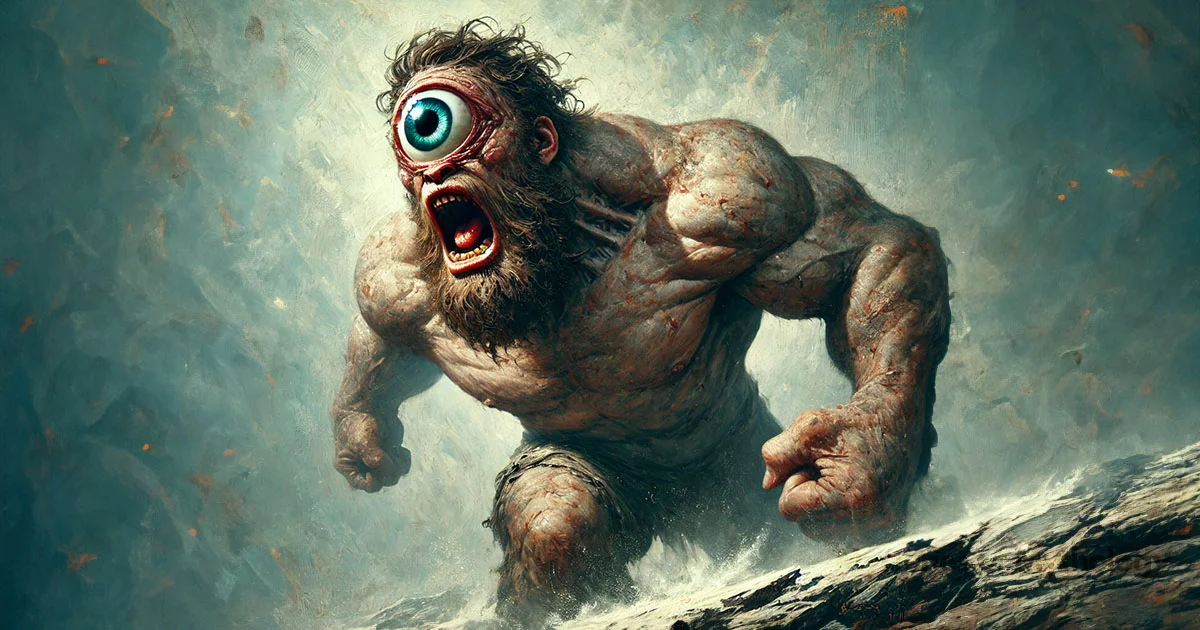
Family
Hephaestus had a complex family background. He was the son of Zeus, the king of the gods, and Hera, the queen of the gods.
In some myths, Hera gave birth to him alone without Zeus. Hephaestus was married to Aphrodite, the goddess of love and beauty, but they had a troubled marriage marked by Aphrodite’s numerous affairs. Hephaestus’s full siblings (meaning they were from Zeus and Hera) included Ares, the god of war, Hebe, the goddess of youth, and Eileithyia, the goddess of childbirth.
Family Tree
Parents
Father
Zeus (in some versions)
Mother
Hera
Consorts
Wife
Aphrodite
Lovers
Aglaea, Cabeiro, Aetna
Full Siblings (Zeus and Hera)
Brothers
Ares
Sisters
Hebe, Eileithyia
Children
Sons
Erichthonius, Cacus, Palaistra
Daughters
Eucleia, Euthenia, Philophrosyne, Aex, Cabiro, Eupheme, Cabeirides, Palikoi, Thalia
Mythology
Birth and Rejection
Hephaestus’s birth story is a big part of his myth. There are two main versions, both involving him being rejected because of his physical appearance
Version 1: Hera’s Solo Creation
In this version, Hera, queen of the gods, was jealous and angry. Her husband Zeus had given birth to Athena all by himself – she had sprung fully formed from his head. Hera wanted to prove she could create life independently too. Using her divine powers, Hera conceived and gave birth to Hephaestus without any male involvement.
Hephaestus was born with a noticeable physical difference, unlike the typically perfect Olympian gods. Most myths describe him as having misshapen or weak legs, which made him limp when he walked. Shocked and disgusted by her son’s imperfection, Hera made a cruel decision. She couldn’t bear the thought of an “ugly” god on Mount Olympus.
In a moment of anger and shame, Hera threw the infant Hephaestus from the top of Mount Olympus. Hephaestus plummeted through the sky for an entire day. In this version, Hephaestus was discovered by the Nereid Thetis and her sisters, who nursed him back to health.
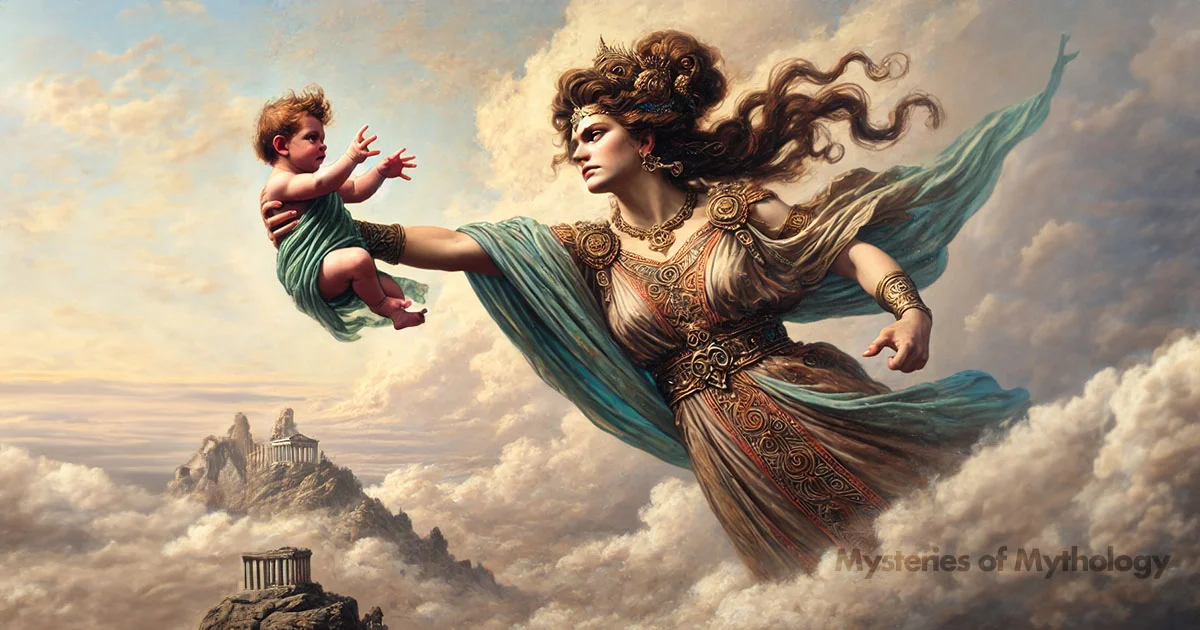
Version 2: Zeus and Hera’s Child
In this version, both Zeus and Hera are Hephaestus’s parents. Zeus and Hera were known for their fierce arguments. During one particularly heated fight, a fully grown Hephaestus got involved in trying to defend his mother. In his anger, Zeus grabbed his son and threw him from Mount Olympus, mirroring Hera’s action in the other myth.
This great fall was said to have caused Hephaestus’s leg deformity or lameness. After falling for a day and a night, he landed on the island of Lemnos. This spot, later revered as the “Lemnian earth,” became a sacred site due to its association with the fallen god’s healing powers.
Unlike in the previous tale, in which the Nereid Thetis rescued him, here, the Sintian people offered aid and shelter.
What’s interesting about both versions is that they aren’t from different sources. Both are featured in Homer’s Iliad, the first version after he was born and the second when he was fully grown.
Return to Olympus
Whichever version is used, the sentiment is that Hephaestus was rejected from Mount Olympus by his parents and refused to return.
Over many years in the ocean, he became an extremely skilled blacksmith. But despite his impressive achievements, the memory of Hera’s rejection and his fall from Olympus remained fresh in his mind. As he honed his metalworking abilities, his desire for revenge grew.
Hephaestus devised a plan to take revenge on Hera. He crafted an elaborate golden throne with a hidden mechanism to trap whoever sat on it. Disguised as a gift from Zeus to Hera, the throne was adorned with intricate designs, golden vines, and an otherworldly glow. Delighted by what she thought was a gift from Zeus, Hera sat on the throne, triggering the trap that bound her with unbreakable chains.
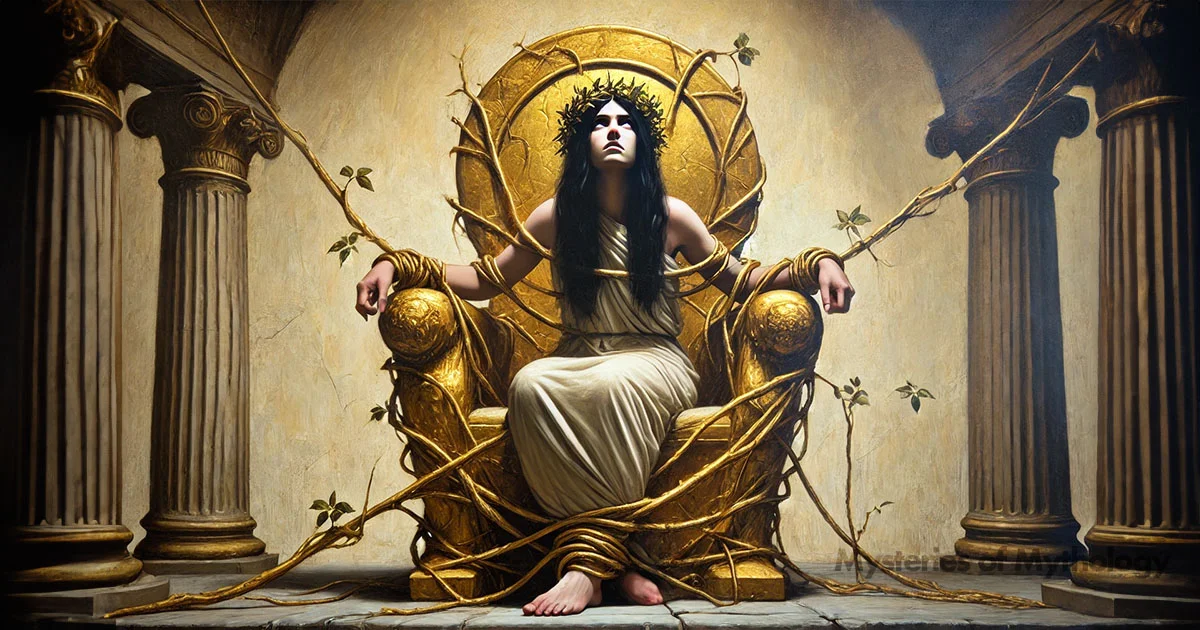
Hearing Hera’s cries for help, the other gods rushed to assist her but were unable to free her. Even Ares’s war blade and Athena’s wisdom were ineffective in unlocking the intricate mechanism. It was Dionysus who identified Hephaestus as the creator, having encountered him while visiting the Nereids in the sea.
During his work in the forge, Athena visited Hephaestus, praising his strategic mind and offering him new tools and a magnificent workshop in exchange for freeing Hera. However, Hephaestus dismissed her and continued with his work. Aphrodite then visited him, promising him a tour of Olympus and her bedchambers, but he remained unmoved. Even Ares’s attempt to intimidate him failed to sway him.
Realising that threats wouldn’t work, Dionysus approached Hephaestus with understanding and camaraderie. Bringing his finest wine, Dionysus spoke of Hephaestus’s brilliance and shared stories of rejection and pain. This approach resonated with Hephaestus, who eventually agreed to return to Olympus, not as an act of submission, but on his own terms, ready to negotiate his place among the gods.
Escorted by Dionysus, they approached the gates of Olympus with mixed emotions—anger, hope, and anticipation. Zeus awaited him, radiating warmth and praising him for his craftsmanship and resilience. The grandeur of Olympus was far more beautiful than the smoke-stained caves he had lived in.
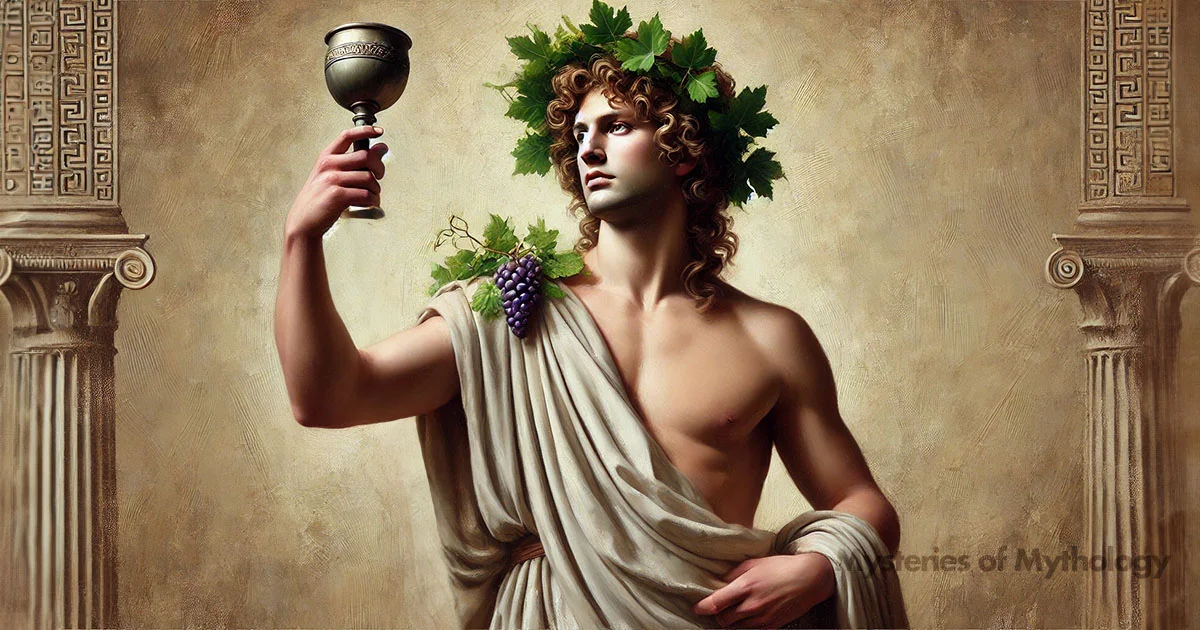
Zeus showed him the Olympian forges, filled with unparalleled resources and tools. Powerful and skilled Cyclopes worked tirelessly, creating a symphony of creation. Zeus declared all these resources at Hephaestus’s disposal.
The core of Hephaestus’s return was his confrontation with Hera. Still bound by his trap, Hera appeared vulnerable and remorseful. She apologized, acknowledging her past wrongs and the pain she had inflicted. After contemplating what his mother said, he laid down his condition: Hera’s release in exchange for marrying Aphrodite.
Hera agreed. With Zeus’s confirming nod, Hephaestus deactivated the trap. The golden vines dissolved, and Hera, tearful, embraced him. Zeus declared a grand feast celebrating Hephaestus’s return and his upcoming union with Aphrodite. No longer ostracised, Hephaestus, the master craftsman, was finally home on Olympus.
Marriage to Aphrodite
Hephaestus’s marriage to Aphrodite, the goddess of love and beauty, was challenging. Although he deeply loved her, her affairs marred their union, particularly with Ares, the god of war.
Hephaestus famously crafted an unbreakable net and caught them in the act of making love, exposing their affair to the other gods.
“Soon shall both lose their desire to sleep, but the snare and the bonds shall hold them until her father pays back to me all the gifts of wooing that I gave him for the sake of his shameless girl; for his daughter is fair but bridles not her passion.”
(Homer, Odyssey 8.317–20, translated to English by A. T. Murray.)
Despite the humiliation, Hephaestus remained married to Aphrodite.
Master Craftsman
As the divine blacksmith, Hephaestus was renowned for his extraordinary craftsmanship. His creations included:
- The Shield of Achilles: Described in Homer’s “Iliad,” it was a masterpiece of art and function.
- Armour of Heracles: Provided protection for the hero in his many labours.
- Chains of Prometheus: Unbreakable chains that bound the Titan Prometheus as punishment from Zeus.
- Pandora: The first woman, created from clay at Zeus’s command, bringing both beauty and misfortune to mankind.
Hephaestus also built the palaces of the gods on Mount Olympus and created various automatons, including golden handmaidens who could assist him in his work.
Workshops and Assistants
Hephaestus’s workshops were legendary, often depicted as being located beneath volcanic islands like Lemnos and Sicily. These locations provided the heat and fire necessary for his metalworking. He was assisted by the Cyclopes, giant one-eyed beings who helped him forge the gods’ powerful and beautiful artefacts.
Wrath and Revenge
Despite his generally peaceful nature, Hephaestus was capable of vengeance. Aside from trapping Hera on the golden throne, he also sought revenge on Aphrodite and Ares. In another myth, he punished the river god Scamander for insulting him by setting the river on fire with his creations.
Athena and Hephaestus
In another myth, Hephaestus played an important role in establishing Athens. The story begins when he develops an interest in his half-sister Athena. Both deities are often seen as counterparts, embodying creativity and craftsmanship. They brought the gifts of wisdom, artistry, and skill to humanity.
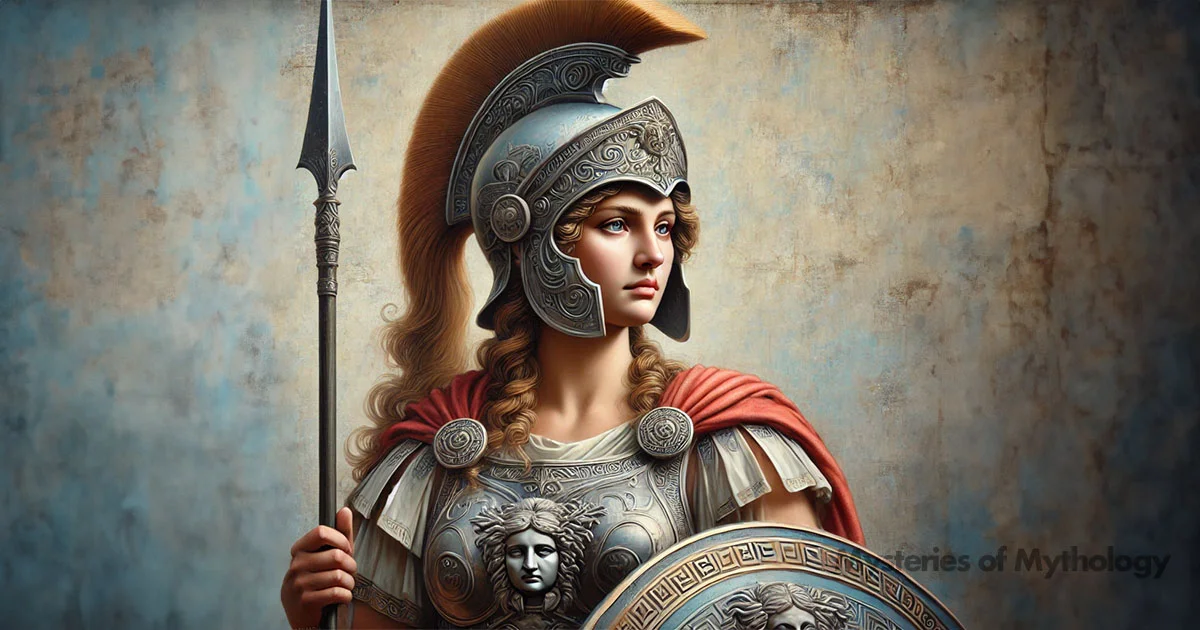
Hephaestus attempted to court Athena, but when she rejected him, which led to him trying to rape her. In his pursuit, his semen fell on the earth, impregnating the earth primordial, Gaia. From this union, Erichthonius was born a future king of Athens. Erichthonius became a symbol of the city’s divine favour and was credited with founding many of its cultural institutions.
Hephaestus and the Trojan War
According to the Iliad, Hephaestus crafted new armour for Achilles after Hector took his previous set from Patroclus’s body. The shield was particularly magnificent, decorated with scenes of human life, as detailed by Homer.
Later, during Achilles’ rampage, the river god Scamander attempted to drown him in retaliation for filling the river with Trojan corpses. Hera sent Hephaestus to save Achilles. Hephaestus threatened to scorch Scamander with fire, compelling the river god to release Achilles immediately.
Other Myths
He played roles in various other myths. During the war between the Olympian gods and the Giants, he killed the Giant Mimas. Another significant myth involves the creation of Pandora, the first woman. According to Hesiod, Zeus ordered Hephaestus to craft Pandora as a punishment for humanity after Prometheus stole fire from the gods. Pandora, whose name means “all-gifted,” was designed to bring misfortunes to mankind, thus fulfilling Zeus’s intention to unleash every conceivable evil upon humanity.
Cultural Significance
Hephaestus held a unique place in Greek mythology, embodying both the creative and destructive power of fire and metalworking. His dual nature as an imperfect god who overcame rejection to earn his place among the Olympians reflects themes of resilience, ingenuity, and the value of craftsmanship. Blacksmiths and artisans worshipped him, and his myths underscored the importance of skill and hard work in ancient Greek society. His legacy continues to influence modern perceptions of the artist and craftsman as integral yet often underappreciated members of society.
Worship
Festivals
Athens held the most famous festivals for Hephaestus, where he was highly respected as the father of Erichthonius, the city’s founding hero. The Hephaestia, held every four years, featured a torch race and offerings to the god. During the Chalkeia festival, craftsmen paraded through Athens to honour Hephaestus and Athena.
In other parts of Greece, he was linked to the Cabiri mystery cult, which he was said to have fathered. These secret rituals likely involved initiation ceremonies, feasts, and sacrifices, mainly practised in Asia Minor, Macedonia, Boeotia, and some northeastern Aegean islands.
Temples
While not as widely worshipped as other Olympian gods, Hephaestus had important religious centres on Lemnos island and in Athens. On Lemnos, his supposed landing spot after being thrown from heaven was considered sacred and believed to heal various ailments, including snake bites.
In Athens, a large temple called the Theseium stood near the city centre, housing statues of both Hephaestus and Athena. Hephaestus also had a few temples in Sicily, where some myths placed his workshop.
Pop Culture
Hephaestus, known for his skill in crafting divine weapons and artefacts, has made significant appearances in modern pop culture, reflecting his enduring legacy as a master craftsman and intriguing deity. Here are some notable instances where Hephaestus has appeared or influenced contemporary media:
Movies and Television
- Percy Jackson Series: Hephaestus is featured in the “Percy Jackson & the Olympians” series, both in the books by Rick Riordan and their subsequent film adaptations. In these stories, he is portrayed as the god of blacksmiths and fire, with his forges hidden in volcanic mountains and underwater.
- Hercules: The Animated Series: This Disney show includes Hephaestus as a character, presenting him as a kind-hearted but often overlooked god who assists Hercules and other characters with his incredible inventions and craftsmanship.
- Justice League Animated Series: In the DC Comics animated universe, Hephaestus is depicted crafting the armour and weapons for the Amazons, including Wonder Woman’s Lasso of Truth and her indestructible bracelets.
Video Games
- God of War Series: In this popular action-adventure game series, Hephaestus appears as a key character in “God of War III.” He is depicted as a tragic figure who, despite his incredible talents, has suffered greatly and becomes entangled in the gods’ complex relationships and power struggles.
- Assassin’s Creed Odyssey: This game, set in Ancient Greece, features Hephaestus’s Forge, where players can upgrade their weapons and armour, emphasizing his role as the ultimate craftsman.
- Hades: In this critically acclaimed roguelike dungeon crawler, Hephaestus is indirectly referenced through various infernal weapons and artefacts that players can use, highlighting his association with blacksmithing and fire.
Literature
- Rick Riordan’s Works: Beyond “Percy Jackson,” Hephaestus appears in Riordan’s other series, including “The Heroes of Olympus,” where his children (the demigod offspring) often play crucial roles, inheriting his mechanical genius and inventiveness.
- Marvel Comics: Hephaestus appears in various Marvel comics, often helping other gods or superheroes with his unmatched skills in crafting powerful weapons and devices.
Other Media
- Music: The character of Hephaestus has inspired songs and musical compositions, often focusing on themes of fire, craftsmanship, and resilience. Bands like Blacksmith have even named albums after him, celebrating his mythic status.
- Dungeons & Dragons: In this popular tabletop role-playing game, Hephaestus inspires various deities and characters associated with smithing, crafting, and fire, influencing the game’s lore and the creation of magical items.
Frequently Asked Questions
What was Hephaestus known for?
Hephaestus was known for his unparalleled skill in blacksmithing, metalworking, and crafting divine weapons, armour, and jewellery for gods and mortals.
Why did Zeus cripple Hephaestus?
According to some myths, Zeus crippled Hephaestus by throwing him from Mount Olympus during a dispute, causing his leg deformity.
Did Aphrodite love Hephaestus?
Aphrodite did not truly love Hephaestus; their marriage was marked by her infidelities, most notably with Ares, the god of war.
Is Hephaestus Zeus’ son?
In most myths, Hephaestus is the son of Zeus and Hera. However, some versions claim Hera bore him alone without Zeus.
Did Hephaestus have a child with Aphrodite?
No, Hephaestus did not have any children with Aphrodite. His children were with other consorts, such as Aglaea and the nymph Cabeiro.
References
- Homer, The Iliad
- Homer, The Odyssey
- Hesiod, Theogony
- Hesiod, Works and Days
- Hesiod, The Shield of Heracles
- Hesiod, Astronomy Fragments
- The Homeric Hymns
- Epic Cycle, The Cypria Fragments
- Epic Cycle, The Little Iliad Fragments
- Pindar, Odes
- Greek Elegaic Mimnermus, Fragments
- Greek Elegaic Solon, Fragments
- Aeschylus, Agamemnon
- Aeschylus, Prometheus Bound
- Aeschylus, Fragments
- Aristophanes, Birds
- Herodotus, Histories
- Plato, Alcibiades
- Plato, Cratylus
- Plato, Critias
- Plato, Protagoras
- Plato, Republic
- Apollodorus, The Library
- Apollonius Rhodius, The Argonautica
- Callimachus, Hymns
- Callimachus, Fragments
- Greek Papyri III Euphorion, Fragments
- Diodorus Siculus, The Library of History
- Strabo, Geography
- Pausanias, Description of Greece
- The Orphic Hymns
- Antoninus Liberalis, Metamorphoses
- Aelian, On Animals
- Philostratus the Elder, Imagines
- Philostratus the Younger, Imagines
- Philostratus, Life of Apollonius of Tyana
- Ptolemy Hephaestion, New History
- Quintus Smyrnaeus, Fall of Troy
- Nonnus, Dionysiaca

